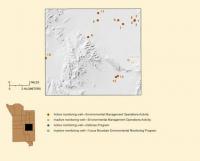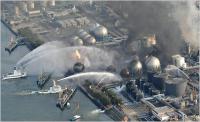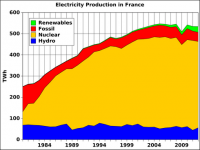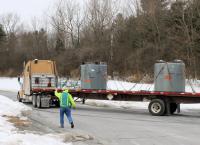-
Benchmark data set validates global nuclear reactor codes
Nearly 100 commercial nuclear reactors supply one-fifth of America’s energy. For each fuel rod in a reactor assembly, only 5 percent of its energy is consumed before fission can no longer be sustained efficiently for power production and the fuel assembly must be replaced. Power plants currently store the used fuel on-site. Information on the composition of the used fuel is essential for the design of safe storage, transportation, and final repository facilities and for inspection and verification to safeguard nuclear materials. Improved accuracy in prediction of the spent fuel isotopic composition leads to increased efficiency in the facility designs and higher confidence in the safeguard protocols.
-
-
New fuel materials to make nuclear reactors safer
Nuclear power is an important energy source in the United States and around the world and is essential as a clean energy to reduce current carbon emissions from fossil fuels. However, many people feel the risk of nuclear accidents does not outweigh the benefits associated with nuclear energy. Scientists are exploring new materials for nuclear fuel, which could make current light water reactors (LWRs) safer.
-
-
Researchers crack 50-year-old nuclear waste problem, making waste storage safer
Researchers have adapted a technology developed for solar energy in order to selectively remove one of the trickiest and most-difficult-to-remove elements in nuclear waste pools across the country, making the storage of nuclear waste safer and nontoxic — and solving a decades-old problem. The scientists figure out how to remove americium from nuclear waste pools, opening the door for expanding the use of one of the cleanest and efficient energy sources on the planet.
-
-
We still don’t really know the health hazards of a nuclear accident
Five years after the nuclear disaster in Fukushima and thirty years after the Chernobyl accident, scientists are still disagreeing about the impact on human health — such as how many people have got cancer as a result and how dangerous the exclusion zones currently are. The people of Fukushima, except those in the worst contaminated areas, will eventually be encouraged to return to their homes. In the absence of better understanding, scientific and political arguments about how safe the radiation levels are will continue. What is abundantly clear, though, is that we need to understand the comparative health effects of radiation versus relocation. Developing a new approach in our response to nuclear accidents and the decisions that are made in their immediate aftermath is vital so that we can avoid unnecessary panic and evacuation — something virtually all scientists agree on.
-
-
“Acceptable risk” is a better way to think about radiation exposure in Fukushima
Five years after the Fukushima disaster, many of these people remain refugees, unable to return home for fear of radiation exposure. As the radioactivity cleanup continues, people are coming to an uncomfortable realization: although cleanup can reduce the level of radioactive contamination, the environmental radiation dose levels within the prefecture will remain elevated for many generations before they finally reach the very low levels that existed prior to the accident. So, when will it be safe for people to return to their homes and to normal life in the Fukushima Prefecture? With regard to radiation exposure, “safe” really means an “acceptable level of risk,” and not everyone agrees on what is acceptable. Providing people with this risk characterization information, at the very least, is within the power of all radiation regulatory agencies, even if achieving complete cleanup of the environment is beyond their reach. This public information void about radiation risks needs to be filled. People can make their own decisions once they’re empowered with credible and intelligible risk information.
-
-
Remote detection of radioactive materials
National security experts believe terrorists continue to be interested in such devices for terror plots. Now researchers have proposed a new technique remotely to detect the radioactive materials in dirty bombs or other sources. It is the increased ion density that the researchers aim to detect with their new method. They calculate that a low-power laser aimed near the radioactive material could free electrons from the oxygen ions.
-
-
Radioactive strontium, cesium from Fukushima continue to leak to the ocean
Scientists investigated the levels of radioactive strontium and cesium in the coast off Japan in September 2013. Radioactive levels in seawater were 10 to 100 times higher than before the nuclear accident, particularly near the facility, suggesting that water containing strontium and cesium isotopes was still leaking into the Pacific Ocean.
-
-
News coverage of Fukushima disaster inadequate
Five years after the 2011 Fukushima Daiichi nuclear disaster in Japan, the disaster no longer dominates U.S. news headlines, although experts say it is a continuing disaster with broad implications. A new analysis finds that U.S. news media coverage following the disaster minimized health risks to the general population.
-
-
The lasting legacies of Chernobyl and Fukushima
It is thirty years since the Chernobyl nuclear disaster. It is also five years since the Fukushima disaster. Greenpeace says that to mark these anniversaries, it has commissioned reviews of scientific studies examining the continued radioactive contamination in the affected areas, and the health and social effects on the impacted populations.
-
-
Secretive Area 6 used to test aerial radiation detection equipment

Top-secret Nevada site – even more secret than neighboring Area 51 — is used by Pentagon, DHS to test drones equipped with sensors to detect radioactive material which could be used in dirty bombs. The site, located in Yucca Flat, was once used for nuclear testing.
-
-
Fukushima five years on: Three lessons from the disaster

It has been five years since the emergency sirens sounded at Japan’s Fukushima Daiichi power plant following the massive 2011 earthquake and subsequent devastating tsunami. The partial meltdown of three reactors caused approximately 170,000 refugees to be displaced from their homes, and radiation releases and public outcry forced the Japanese government to temporarily shut down all of their nuclear power plants. On the fifth anniversary of the partial meltdown at Japan’s Fukushima Daiichi Power Plant, Stanford’s Rodney Ewing says we should rethink our language, reassess natural disaster risks, and appreciate the links between nuclear energy and renewables.
-
-
Bird droppings caused N.Y. nuclear reactor power outage

On 14 December, one of the nuclear reactors at Indian Point nuclear power plant outside New York City was safely shut down for three days, following an electrical disturbance on outdoor high voltage transmission lines. Outside experts investigating the incident found the bird droppings were the cause of the electrical disturbance.
-
-
2014 French nuclear accident more serious than official reports suggested

German media charges that the French nuclear authority and the French company operating the aging Fessenheim nuclear facility in France, concealed the seriousness of the April 2014 incident at the site. The French nuclear authorities withheld information not only from the German government, but also from the IAEA, to which they were required to submit a detailed report about the incident.
-
-
Truck carrying toxic nuclear materials stolen in Mexico

Five Mexican states have been placed on a state of alert after a truck carrying a container of dangerous radioactive material was stolen, the Mexican Interior Ministry has said. The material could cause permanent or serious injury to a person who is in contact with it for a short time, and is fatal when exposure lasts for more than a few hours.
-
-
Air data can be used to reconstruct radiological releases
New research demonstrates that experts can use data from air sampling technology to not only detect radiological releases, but to accurately quantify the magnitude and source of the release. This has applications for nuclear plant safety, as well as national security and nuclear nonproliferation monitoring.
-
More headlines
The long view
Keeping the Lights on with Nuclear Waste: Radiochemistry Transforms Nuclear Waste into Strategic Materials
By John Domol
How UNLV radiochemistry is pioneering the future of energy in the Southwest by salvaging strategic materials from nuclear dumps –and making it safe.
Model Predicts Long-Term Effects of Nuclear Waste on Underground Disposal Systems
By Zach Winn
The simulations matched results from an underground lab experiment in Switzerland, suggesting modeling could be used to validate the safety of nuclear disposal sites.
